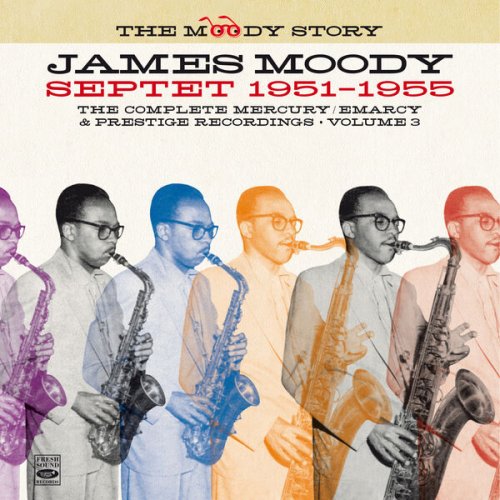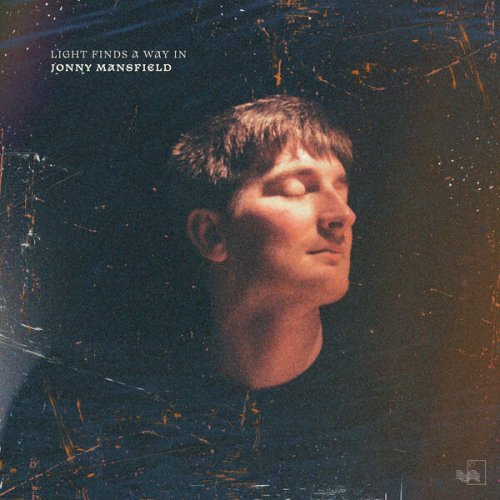James Moody - The Moody Story · James Moody Septet 1951-1955, Vol. 3 (Remastered) (2024) [Hi-Res]

Artist: James Moody
Title: The Moody Story · James Moody Septet 1951-1955, Vol. 3 (Remastered)
Year Of Release: 2024
Label: Fresh Sound Records
Genre: Jazz
Quality: FLAC (tracks) [44.1kHz/24bit]
Total Time: 1:08:31
Total Size: 712 / 369 MB
WebSite: Album Preview
Tracklist:Title: The Moody Story · James Moody Septet 1951-1955, Vol. 3 (Remastered)
Year Of Release: 2024
Label: Fresh Sound Records
Genre: Jazz
Quality: FLAC (tracks) [44.1kHz/24bit]
Total Time: 1:08:31
Total Size: 712 / 369 MB
WebSite: Album Preview
1. Big Ben (Remastered) (04:19)
2. Little John (04:18)
3. Show Eyes (04:23)
4. And You Called My Name (04:12)
5. Jammin' with James (11:39)
6. The Golden Touch (04:11)
7. The Nearness of You (04:54)
8. Donkey Serenade (03:47)
9. Moody's Blue Again (04:35)
10. The Strut (04:04)
11. A Sinner Kissed an Angel (04:03)
12. Wail Moody, Wail (13:58)
James Moody (1925-2010), born in Savannah, GA, and raised in Newark, NJ, developed a passion for music during his teenage years. At 16, he received an alto saxophone and began practicing tirelessly. It was over a year later that he discovered his fondness for the tenor saxophone. While serving in the Army from 1943 to 1946, Moody received musical training and learned the rudiments of the instrument. Shortly after being discharged in the summer of 1946, Moody joined Gillespie's big band. His talent as a soloist garnered attention, blending the innovative styles of Parker and Gillespie with his own approach. However, despite making his recording debut as a leader in 1948, his career seemed to stall.
Early in 1949, quite discouraged, Moody decided to head to Paris, where he found success as a recording artist and collaborated with notable musicians like Miles Davis and Max Roach. He also traveled to Stockholm, recording with Swedish musicians. After his European experience, Moody returned to the US in 1951, signing with Mercury Records and embarking on extensive tours of one-night performances, playing a pivotal role in broadening jazz's appeal among the general public. Ralph Gleason, writing for the San Francisco Chronicle, described Moody’s band as “one of the best small groups in the country, a tightly knit yet loosely swinging unit."
Moody's first recordings with Mercury and subsequent albums for Prestige Records from 1951 1955 showcased his leadership, musical prowess, and his versatility and skill on both alto and tenor saxophones. His septet with musicians like Dave Burns, Pee Wee Moore, and singers Babs Gonzales and Eddie Jefferson resulted in memorable performances. Moody's records captured not just the danceable rhythms but also delved into intricate jazz arrangements, catering to a more discerning audience. Despite facing challenges in gaining recognition from critics and being labeled as a rhythm and blues musician, these Moody's recordings reveal a modern and robust swinging sound reminiscent at times of the Gillespie-Tadd Dameron style, constantly captivating and attracting attention.
—Jordi Pujol
Early in 1949, quite discouraged, Moody decided to head to Paris, where he found success as a recording artist and collaborated with notable musicians like Miles Davis and Max Roach. He also traveled to Stockholm, recording with Swedish musicians. After his European experience, Moody returned to the US in 1951, signing with Mercury Records and embarking on extensive tours of one-night performances, playing a pivotal role in broadening jazz's appeal among the general public. Ralph Gleason, writing for the San Francisco Chronicle, described Moody’s band as “one of the best small groups in the country, a tightly knit yet loosely swinging unit."
Moody's first recordings with Mercury and subsequent albums for Prestige Records from 1951 1955 showcased his leadership, musical prowess, and his versatility and skill on both alto and tenor saxophones. His septet with musicians like Dave Burns, Pee Wee Moore, and singers Babs Gonzales and Eddie Jefferson resulted in memorable performances. Moody's records captured not just the danceable rhythms but also delved into intricate jazz arrangements, catering to a more discerning audience. Despite facing challenges in gaining recognition from critics and being labeled as a rhythm and blues musician, these Moody's recordings reveal a modern and robust swinging sound reminiscent at times of the Gillespie-Tadd Dameron style, constantly captivating and attracting attention.
—Jordi Pujol

![Nectar Woode - Live at Village Underground (Live At Village Underground) (2025) [Hi-Res] Nectar Woode - Live at Village Underground (Live At Village Underground) (2025) [Hi-Res]](https://img.israbox.com/img/2025-12/15/eiazyx7yigt2lhbv1tcd3eos6.jpg)
![Coco Chatru Quartet - Lost Christmas (2025) [Hi-Res] Coco Chatru Quartet - Lost Christmas (2025) [Hi-Res]](https://www.dibpic.com/uploads/posts/2025-12/1765719561_coco-chatru-quartet-lost-christmas-2025.jpg)
![Dave Holland - Emerald Tears (1977/2025) [Hi-Res] Dave Holland - Emerald Tears (1977/2025) [Hi-Res]](https://www.dibpic.com/uploads/posts/2025-12/1765891427_cover.jpg)
![Rachel Kitchlew, SFJ - Flirty Ghost (2025) [Hi-Res] Rachel Kitchlew, SFJ - Flirty Ghost (2025) [Hi-Res]](https://www.dibpic.com/uploads/posts/2025-12/1765896408_qvf41hr1ljj8a_600.jpg)
![Betty Carter - The Music Never Stops (2019) [Hi-Res] Betty Carter - The Music Never Stops (2019) [Hi-Res]](https://www.dibpic.com/uploads/posts/2025-12/1765896843_bcmn500.jpg)


